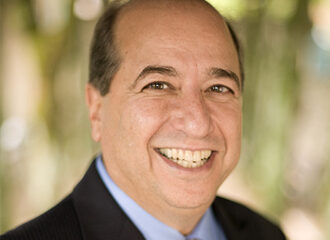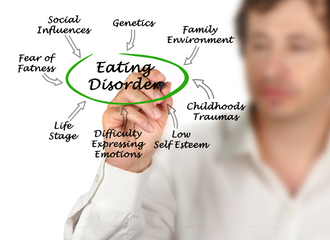Written by: Samantha DeCaro, PsyD
Director of Clinical Outreach and Education, The Renfrew Center
In a culture obsessed with dieting and weight loss, the diet industry continues to profit from the rebranding and repackaging of disordered eating strategies.
Disordered eating is so common in our culture that even experienced medical and mental health professionals sometimes minimize the warning signs of a diagnosable eating disorder and praise the weight loss that can temporarily occur from restriction, over-exercise and other harmful behaviors.
To understand the differences between eating disorders and disordered eating, it can be helpful to conceptualize these behaviors on a spectrum. On the far end of this spectrum, those with eating disorders experience significant psychological, medical and relational impairments in their daily lives, and have difficulty breaking the cycle without professional support. However, those who engage in some forms of disordered eating (closer to the middle of the spectrum, for example) are by no means immune to the harmful impacts.
What Is Disordered Eating?
If we visualize eating behaviors on a spectrum, on one end we would imagine the diagnosable eating disorders in the DSM 5 (e.g., anorexia, bulimia, binge eating disorder, OSFED, and ARFID), while on the other end we envision the concept of “Intuitive Eating.” To fully understand forms of disordered eating, it might be valuable to first identify the tenets of its opposite, as many believe disordered eating and intuitive eating are diametrically opposed.
Intuitive Eating is a term coined in 1995 by the dieticians Evelyn Tribole and Elyse Resch, co-authors of the book, “Intuitive Eating: A Revolutionary Program that Works.” Intuitive eating includes 10 principles:
-
- Reject the Diet Mentality: Don’t fall for the myth that bodies can change shape or size quickly and effortlessly. Diets don’t work in the long run. Our bodies know how to outsmart diets by conserving energy and increasing hunger. It’s not you, it’s them.
- Honor Your Hunger: When we don’t nourish ourselves adequately, we only increase the likelihood of binge eating. Tuning into and honoring hunger cues strengthens and improves the relationship we have with our bodies.
- Make Peace with Food: All foods fit and there are no “good” or “bad foods” (except in the case of a legitimate medical allergy or issue). Labeling foods as forbidden only puts us in a mindset of scarcity and heightens our cravings for those items.
- Challenge the Food Police: Notice any judgmental thoughts you have about eating certain foods and practice re-appraising those thoughts. All foods are morally neutral and are not connected to your worth.
- Discover the Satisfaction Factor: Allow yourself to enjoy foods that are satisfying and delicious. Food is much more than just fuel, despite diet culture’s unhelpful and inaccurate messages. Food can and should be a source of connection, culture, and pleasure.
- Feel Your Fullness: Check in with yourself and observe your body’s signals. Notice what it feels like in your body to be full and satisfied, as well as when your hunger gradually subsides.
- Cope with Your Emotions with Kindness: When we deprive ourselves of the food we need and want, food can easily become a powerful source of temporary comfort and relief. It can take time to learn other, more effective ways to cope with emotions when food has been the primary coping strategy for so long.
- Respect Your Body: Our bodies each have their own set point and attempts to manipulate that set point only set us up for failure. Accepting that our bodies are genetically designed to be a certain shape and size is one of the first steps on this journey. We all deserve nourishment, pleasure, respect, and dignity regardless of weight, shape or size.
- Movement—Feel the Difference: Choose movement based on how the movement feels to you both during and after doing it, as opposed to the hope that it will shrink or change parts of your body. Experiment with different types of movement, and notice what activities increase your energy levels, reduce stress, bring joy, and/or provide connection with self or others.
- Honor Your Health with Gentle Nutrition: Eating “perfectly” is not the road to mental and physical wellness. It is possible to honor your health while also allowing yourself to eat pleasurable foods. Focus on the big picture rather than micro-managing every meal.
Unfortunately, diet culture has co-opted the term “Intuitive Eating”, and many consumers are tricked by this terminology only to discover they have been lured into yet another ineffective diet. Diet culture continues to push the myth that permanent weight loss is possible through the next fad, despite the evidence that most diets invariably end with rebound weight gain and other detrimental side effects along the way.
Disordered eating comes in many forms with many labels, but it is essentially the opposite of every “intuitive eating” principle. Dieting and disordered eating requires people to disconnect from their body’s signals to blindly follow a set of manufactured, external “rules” dictating what to eat, when to eat, and/or how much to eat.
Disordered eating is the act of purposefully ignoring cravings and preferences if they do not fit perfectly within the rules of the diet, demonizing certain foods or food groups without medical cause, associating certain food choices with character defects, consistently turning to food to cope with emotions, planning out “cheat meals”, engaging in behaviors to “undo” caloric intake, engaging in behaviors to “earn” caloric intake, or repeatedly manipulating food to pursue a body shape and/or size that was never meant to genetically be.
Disordered eating can cause fatigue, reduced metabolism, irritability, depressed mood, sleep issues, muscle loss, nutritional deficiencies, headaches, and more problems. Oftentimes, it is the empty promise of permanent weight loss that drives these behaviors, paired with the faulty belief that willpower is the only barrier to achieving it.
What is an Eating Disorder?
Eating disorders and disordered eating behaviors overlap in many ways, and the signs and symptoms of an eating disorder can frequently get lost in the shuffle of diet culture.
Nonetheless, clinical eating disorders are serious mental health conditions and are among the deadliest psychiatric diagnoses in the DSM 5, second only to opioid abuse. To be diagnosed with an eating disorder, specific criteria and a certain level of duration and frequency of restricting, bingeing, and/or purging must be met.
Eating disorders are irrational disorders driven by emotional avoidance, intense urges, body image disturbances (with the exception of ARFID) and obsessive, intrusive thoughts.
Unfortunately, logic alone rarely has much of an effect on these powerful forces. The mere knowledge that these behaviors are causing serious medical and psychological harm is not usually enough to immediately motivate someone with an eating disorder to pursue recovery.
It is not uncommon for ambivalence, denial and/or minimization to take hold as the person grapples with the concerns of loved ones and the various physical, social and psychological issues that begin to surface.
Eating disorders rarely travel alone, and frequently co-occur with various medical complications, anxiety, depression, OCD, PTSD, and/or substance use, which require a multi-disciplinary treatment approach that often includes individual therapy, family therapy, dietary supervision, psychotropic medications, and medical monitoring.
Conclusion
Disordered eating and eating disorders share many similarities, and both can potentially cause significant problems physically, mentally and relationally. Eating disorders often require professional support to recover given the frequency, duration, and severity of the symptoms and the subsequent impairments present at school, work, and/or within the individual’s relationships.



